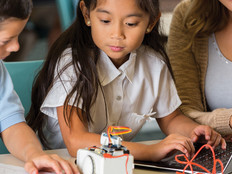K–12 Schools Work to Incorporate Computer Science into Curriculums
Forecasts report that computer science skills will be essential for the future workforce, creating a need for K–12 experts to work harder to incorporate such lessons into the curriculum.
According to the App Association, there will be approximately 1 million unfilled computing jobs in 2024. Research conducted by the Bureau of Labor Statistics has found that number could be reached by 2020. These findings have put a fire underneath educators and K–12 organizations to refocus efforts to teach computer science skills.
“We don’t just need computer science graduates to fill computing jobs; we need people with technical abilities to fill jobs in almost every industry,” Victoria Espinel, president of Software.org: the BSA Foundation and chair of the World Economic Forum’s Global Future Council on the Digital Economy and Society, writes in a blog post. “Those jobs will be created by advancements in software, and kids need to prepare now for those possibilities. They won’t all need computer science degrees, but basic digital literacy will be essential.”
To facilitate increased focus from educators, the International Society for Technology in Education updated its standards for computer science curricula in July of this year, the first time since 2012, EdScoop reports. The new guidelines encourage teachers to move beyond a lecture-style pedagogy to teach computer science, and instead find creative ways to show students how computational thinking can be used in vastly different ways across a wide spectrum of topics.
MORE FROM EDTECH: Read how Microsoft is pairing K–12 classrooms with computer science experts!
Engage Students in Data Science Through Activities
When asked to imagine what data analysis in schools might look like, many might picture a classroom full of students huddled around computer screens, inputting numbers into spreadsheets and running simulations until their eyes water.
However, computational thinking does not have to be confined to a classroom. By using personal devices and data science programs like Tableau, teachers can come up with new ways to incorporate data science to teach kids STEM skills while still having fun.
At Excel Public Charter School in Kent, Wash., students are using sabermetrics to analyze one another’s athletic skills in physical education class to determine their best uses on the kickball field, EdSurge reports.
Excel’s Eric Murphy, the teacher that came up with the idea, gave each student a chance to be a “data captain,” capturing students’ play statistics to create athlete profiles. Students could keep track of their improvement over time and use player profiles to strategize optimal fielding techniques when particular students came up to bat.
Incorporating data science into physical education classes created an opportunity to include both athletic and nonathletic students, according to Murphy, while simultaneously teaching students computational thinking skills that resonate beyond the kickball field.
Encourage Autonomy Through Smart Lab Projects
Other K–12 schools have found success by allowing students to pick topics they are interested in, then finding ways for them to inject computer science into those areas.
K–12 schools are creating “SmartLabs,” incorporating modern learning environment technologies like flexible work stations to encourage collaboration, and interactive smartboards for students to present their findings.
At Lucerne Valley Elementary School, students are able to pursue their own projects in a special SmartLab classroom, Victor Valley News reports. Through the program, students can pursue projects ranging from data analytics to digital communications.
In line with ISTE’s new standards, students work under the guidance of a teacher to team up to explore their chosen topics using data science and coding, forgoing tests for electronic portfolios documenting their progress.
“The SmartLab is a state-of-the-art classroom called a STEM center,” Burt Umstead, the school’s principal, told Victor Valley News. “In addition to working with leading edge technology, students develop critical skills such as problem-solving, collaboration, project management and communications.”








